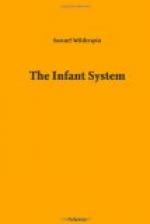To prevent this evil, I have arranged a series, denominated “Developing Lessons,” the great object of which is to induce children to think and reflect on what they see. They are thus formed: at the top is a coloured picture, or series of coloured pictures of insects, quadrupeds, and general objects. For instance, there is one containing the poplar, hawk-moth, and wasp. The lesson is as follows: “The wasp can sting, and fly as well as the moth, which does not sting. I hope no wasp will sting me; he is small, but the hawk-moth is large. The moth eats leaves, but the wasp loves sweet things, and makes a round nest. If boys take the nest they may be stung: the fish like the wasp-grubs.” On this, questions are proposed: Which stings? Which is small and which large? Which eats leaves? Which makes a round nest? &c. &c.
To take another instance. There is a figure of an Italian, to which is appended the following: “The Italian has got a flask of oil and a fish in his hand, and something else in his hand which the little child who reads this must find out. Any child can tell who makes use of the sense of seeing. In Italy they make a good deal of wine; big grapes grow there that they make it with. Italians can sing very well, and so can little children when they are taught.” Questions are likewise proposed on this, as before.
Of these lessons, however, there is a great variety. All schools should possess them: they will effectually prevent the evil alluded to, by checking the apathy of children in learning to read, and calling the teacher’s powers into full exercise. They are equally adapted to spelling and reading.
I will give several specimens of reading lessons in natural history, each of which has a large, well-engraved and coloured plate at the top, copied from nature.
THE EAGLE.
How glad some poor children would be if they could read about the eagle. He is a big strong bird, and has such great wings, and such long sharp claws, that he can dig them into the lamb, hare, rabbit, and other animals, and thus fly away with them to feed his young ones, and to eat them himself. Eagles make such a large nest on the side of some high rock, where nobody can get at it. There used to be eagles in Wales, and there are some now in Scotland, but very few in England, for they do not like to be where there are many people. The Almighty gave man dominion over the birds of the air, as well as over the other animals, and as he gave man power to think, if the eagles become troublesome, men catch them, though they can fly so high; and as the eagle knows this, he likes to keep out of our way, and go into parts of the world where there are not so many people. There are many sorts of eagles: the black eagle, the sea eagle, the bald eagle, and others. They have all strong bills bent down in front, and strong claws. This bird is mentioned in the Bible.




